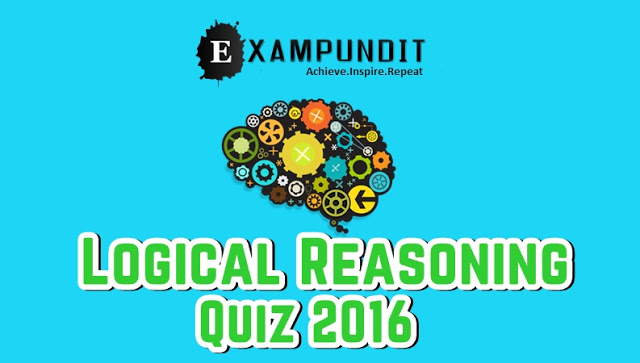Hello and welcome to ExamPundit. Here is a set of Reasoning Quiz for upcoming Bank Exam in 2016.
Read the followings carefully and answer
Rules:
Post answers according to the following format(s)
1-2
2-3
3-4
Or
12345
54213
In case the options are ABCD, use the Appropriate Options.
Do Not Rectify anyone.
If you have any doubt regarding any question of the quiz, kindly ask after the quiz is over i.e answers given.
DO NOT GOOGLE ANSWERS!! IT WILL HAMPER YOUR PREPARATION
Do Not CHAT here. If you have any query, use today’s Ask The Mentor Page.
At least 7 Attempts for Scores.
Exampundit.in reserves the right to choose winner or give scores.
Directions
(Q. 1-5): Study the following information to answer the given questions:
(Q. 1-5): Study the following information to answer the given questions:
Eight people are sitting in two parallel rows containing
four people each, in such a way that there is an equal distance between
adjacent persons. In row 1, A, B, C and D are sitting (but not necessarily in
the same order) and all of them are facing south. In row 2, E, F, G and H are
sitting (but not necessarily in the same order) and all of them are facing
north. Therefore, in the given seating arrangement each member sitting in a row
faces another member of the other row. G sits second to the right of E. The one
who faces E sits to the immediate right of C. A faces the immediate neighbour of
E. H sits to immediate left of the person who faces D. H does not sit at an
extreme end of the line.
four people each, in such a way that there is an equal distance between
adjacent persons. In row 1, A, B, C and D are sitting (but not necessarily in
the same order) and all of them are facing south. In row 2, E, F, G and H are
sitting (but not necessarily in the same order) and all of them are facing
north. Therefore, in the given seating arrangement each member sitting in a row
faces another member of the other row. G sits second to the right of E. The one
who faces E sits to the immediate right of C. A faces the immediate neighbour of
E. H sits to immediate left of the person who faces D. H does not sit at an
extreme end of the line.
1. Who
amongst the following faces A?
amongst the following faces A?
1) E
2) F
3) G
4) H
5) Cannot be determined
2. Who
amongst the following faces the person who sits exactly between G and E?
amongst the following faces the person who sits exactly between G and E?
1) A
2) B
3) C
4) D
5) Cannot be determined
3. Who
amongst the following faces G?
amongst the following faces G?
1) A
2) B
3) C
4) D
5) Cannot be determined
4. Which of
the following is true regarding B?
the following is true regarding B?
1) B sits exactly between C and D.
2) D sits second to the right of B.
3) B sits at an extreme end of the line.
4) B is an immediate neighbour of the person who faces F.
5) None is true
5. Four of
the following five are alike in a certain way based on the given seating
arrangement and thus form a group.
Which is the one that does not belong to that group ?
the following five are alike in a certain way based on the given seating
arrangement and thus form a group.
Which is the one that does not belong to that group ?
1) E
2) D
3) F
4) G
5) A
| Solutions – | ||
|---|---|---|
Directions
(Q. 6-10): Study the following information carefully and answer
the given questions. A word and number arrangement machine when given an input
line of words and numbers rearranges them following a particular rule.
The following is an illustration of input and rearrangement.
Input: 19 our 8
dear 14 13 like even 5 prove 9 appear
dear 14 13 like even 5 prove 9 appear
Step I: appear 5
19 our 8 dear 14 13 like even prove 9
19 our 8 dear 14 13 like even prove 9
Step II: appear 5
even 13 19 our 8 dear 14 like prove 9
even 13 19 our 8 dear 14 like prove 9
Step III: appear
5 even 13 our 19 8 dear 14 like prove 9
5 even 13 our 19 8 dear 14 like prove 9
Step IV: appear 5
even 13 our 19 prove 8 dear 14 like 9
even 13 our 19 prove 8 dear 14 like 9
Step V: appear 5
even 13 our 19 prove 8 like 9 dear 14
even 13 our 19 prove 8 like 9 dear 14
Step V is the last step of the rearrangement. As per rules
followed in above steps, find out, in each of the following questions, the
appropriate steps for the input given below.
followed in above steps, find out, in each of the following questions, the
appropriate steps for the input given below.
Input: ear 17
above 31 uncalm 39 fear 23 14 in memory 33 cause 11 quit
above 31 uncalm 39 fear 23 14 in memory 33 cause 11 quit
6. How many
steps will be needed to complete the rearrangement?
steps will be needed to complete the rearrangement?
1) Four
2) Five
3) Six
4) Seven
5) None of these
7. Which of
the following step would be step IV?
the following step would be step IV?
1) above 11 ear 17 in 23 uncalm 31 quit 14 39 fear memory 33
cause
cause
2) above 11 ear 17 in 23 uncalm 31 39 fear 14 memory 33
cause quit
cause quit
3) above 11 ear 17 in 23 uncalm 31 quit 14 memory 33 39 fear
cause
cause
4) above 11 ear 17 in 23 cause 33 uncalm 31 quit 14 39 fear
memory
memory
5) None of these
8. Which of
the following would be at 7th position from the right in step V?
the following would be at 7th position from the right in step V?
1) 14
2) 31
3) memory
4) quit
5) uncalm
9. In step
V of the rearrangment if ‘11’ is related to ‘ear’ and ‘in’ is related to ‘23’
in a certain way,
V of the rearrangment if ‘11’ is related to ‘ear’ and ‘in’ is related to ‘23’
in a certain way,
which of
the following would ‘quit’ be related to following the same pattern?
the following would ‘quit’ be related to following the same pattern?
1) uncalm
2) 14
3) memory
4) 31
5) None of these
10. Which
step would be the following output?
step would be the following output?
“above 11
ear 17 in 23 uncalm 31 39 fear 14 memory 33 cause quit”
ear 17 in 23 uncalm 31 39 fear 14 memory 33 cause quit”
1) There will be no such step.
2) VI
3) II
4) V
5) III
| Solutions – The machine rearranges one word and one number in each step. First, it rearranges words starting with a vowel in alphabetical order, then it rearranges words starting with a consonant in reverse alphabetical order. For numbers, it first rearranges prime numbers in ascending order, then composite numbers in ascending order. Input: ear 17 above 31 uncalm 39 fear 23 14 in memory 33 cause 11 quit Step I: above 11 ear 17 31 uncalm 39 fear 23 14 in memory 33 cause quit Step II: above 11 ear 17 in 23 31 uncalm 39 fear 14 memory 33 cause quit Step III: above 11 ear 17 in 23 uncalm 31 39 fear 14 memory 33 cause quit Step IV: above 11 ear 17 in 23 uncalm 31 quit 14 39 fear memory 33 cause Step V: above 11 ear 17 in 23 uncalm 31 quit 14 memory 33 39 fear cause Step VI: above 11 ear 17 in 23 uncalm 31 quit 14 memory 33 fear 39 cause |
|---|
Regards
function answer(id){
if(document.getElementById(id).style.display == “block”){
document.getElementById(id).style.display = “none”;
}else{
document.getElementById(id).style.display = “block”;
}
}
#a1{display:none;}
#a2{display:none;}
Team ExamPundit
Sponsored
(adsbygoogle = window.adsbygoogle || []).push({});
This post was last modified on November 27, 2017 8:57 am





